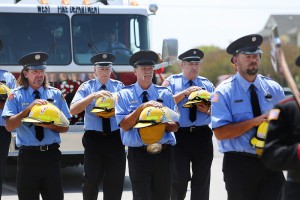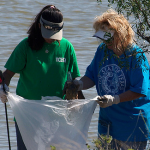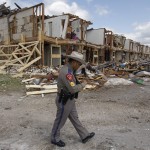Hearing on West Fertilizer Explosion Shows Lack of Regulation and Coordination

Photo by Filipa Rodrigues/KUT News
The aftermath of the explosion at a fertilizer plant in the small town of West, Texas had lawmakers questioning agencies on oversight and safety today.
Two weeks ago today, a fire ignited at a fertilizer plant in the small Central Texas town of West. About twenty minutes later, a massive explosion occurred, killing 15 people, injuring over 200, and destroying nearly 150 homes. Today, at the Texas Capitol, lawmakers questioned state agencies that had oversight over the plant’s safety and regulation, but didn’t get many answers.
Eight state agencies were invited to testify at the House Homeland Security & Public Safety Committee hearing, chaired by state Rep. Joseph Pickett, D-El Paso. As the investigation into the cause of the fire and subsequent explosion is still ongoing, many of the lawmakers questions dealt with fertilizer plant regulation in the state generally, and not whether or not the West disaster could have been avoided.
“The intent of this hearing is to try to shed light on where these facilities are located,” Pickett said at the outset. “This will be a learning process for the community at large. Ultimately, this is probably going to be a national issue.”
What became clear at today’s hearing is that among the several state agencies with oversight of fertilizer plants like West, there is no single agency tasked with safety inspections and coordinating with local governments on emergency response.
The suspected culprit in the explosion is ammonium nitrate, which was stored in large quantities at the West Fertilizer Co. There are 1,105 firms in Texas that store ammonium nitrate, according to testimony today from the Department of Public Safety (DPS), with about 42 fertilizer mixing plants like the one in West.
But since ammonium nitrate isn’t considered an “extremely hazardous” chemical by state and federal agencies, plants only have to report to authorities if they have more than 10,000 pounds of it on hand. The state could have stricter reporting requirements if it chose to, according to David Lakey, Commissioner of the Texas Department of State Health Services (DSHS). The maximum amount the West Fertilizer plant reported to the state was 270 tons.
And the burden for communities to know where these chemicals are stored, and how to respond to emergencies at facilities that store them, falls on local officials. There are over 14,000 facilities in Texas that self-report having “extremely hazardous substances” on site, according to Lakey of DSHS. Representatives from that agency testified that chlorine and battery acid are the most common hazardous substances near communities, but that they only oversee reporting, not safety.
“How do they [the public] know if there’s a facility like this in their area?” asked state Rep. Ron Simmons, R-Carrollton.
“There’s no overarching plan to educate people of what’s in their areas,” replied Steve McCraw, Director of the Department of Public Safety (DPS). Facilities like West are required to share their reports on safety and hazardous chemicals with local officials and emergency planning committees, but that may not always be the case, and those local committees may not always put plans in place to respond to incidents at plants like the one in West.
“Have we done anything to survey the 41 [fertilizer plants] because of what happened in West?” Pickett asked.
W. Nim Kidd, Assistant Director of DPS and Chief of Emergency Management, answered that his agency doesn’t do surveys, but local fire chiefs have the authority to go in and inspect those facilities.
“Could you suggest that to them?” Pickett asked, wondering if the agency could do more to encourage local fire officials to conduct inspections and prepare emergency response plans.
“We have done that through all the planning exercises and training that we provide,” Kidd said.
Other agencies testified similarly that they weren’t in charge of safety or emergency response oversight for a plant like West. “Our job is to facilitate commerce and provide market protection,” Tim Herrman, the State Chemist, testified. His inspectors generally look at fertilizer blends and conduct inspections to make sure that they are secure from theft and vandalism, not inspect for safety or improper storage of chemicals. And there are no state requirements for fire barriers or setbacks for facilities like West.

Photo by Jorge Sanhueza-Lyon/KUT
Members of the West volunteer fire department carry the helmets of fallen firefighters during a procession of fire trucks and emergency vehicles. The procession was followed by a memorial service honoring the victims of the fertilizer plant explosion in West, TX. Thursday, April 25, 2013.
In some cases, a plant or facility will have an emergency response and evacuation plan because of their liability insurance, Eleanor Kitzman, Commissioner of the Texas Department of Insurance, testified. But fertilizer plants aren’t required to have insurance, and in the case of the West plant, their liability insurance “had absolutely no relationship to the amount of risk involved here,” Kitzman said.
“We don’t have a role in how that insurance is administered, or what types of requirements or safety inspections may be involved,” Kitzman testified.
Likewise, the Texas Commission on Environmental Quality (TCEQ) only has limited regulation over plants like West, permitting for dust and air quality from anhydrous ammonia, but not oversight over its ammonium nitrate. TCEQ Commissioner Bryan Shaw told lawmakers that inspections for plants like West are “uncommon” and “complaint-driven.”
While the Texas House hearing was short on answers, on Tuesday U.S. Sen. Barbara Boxer, D-CA, chair of the Senate Environment and Public Works Committee, announced that the committee would also be leading an investigation into the West disaster and chemical safety laws.
“I cannot rest until we get to the bottom of what caused the disaster in West, Texas and the tragic loss of life,” Boxer said in a statement. “It is critical that we find out how this happened.” Boxer also released copies of her questions for two federal agencies that had oversight of the plant, the Environmental Protection Agency (EPA) and Chemical Safety Board (CSB).
The State Fire Marshal’s office said at today’s hearing that they expect their investigation into the origin and cause of the fire to be complete by May 10.

